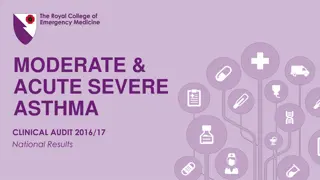Key Audit Matters (KAM) Guidelines and Requirements Overview
Understand the importance of Key Audit Matters (KAM) in the audit process for listed entities and the public sector in South Africa. Learn about the mandatory and voluntary aspects of KAM reporting, as well as the requirements for identifying, evaluating, and communicating significant audit matters. Discover how KAM strengthens oversight, accountability, and governance in the public sector, building public confidence.
Uploaded on Oct 02, 2024 | 1 Views
Download Presentation

Please find below an Image/Link to download the presentation.
The content on the website is provided AS IS for your information and personal use only. It may not be sold, licensed, or shared on other websites without obtaining consent from the author.If you encounter any issues during the download, it is possible that the publisher has removed the file from their server.
You are allowed to download the files provided on this website for personal or commercial use, subject to the condition that they are used lawfully. All files are the property of their respective owners.
The content on the website is provided AS IS for your information and personal use only. It may not be sold, licensed, or shared on other websites without obtaining consent from the author.
E N D
Presentation Transcript
March 2017 KAM workshop
Reputation promise/mission The Auditor-General of South Africa has a constitutional mandate and, as the Supreme Audit Institution (SAI) of South Africa, exists to strengthen our country s democracy by enabling oversight, accountability and governance in the public sector through auditing, thereby building public confidence.
KAM in the public sector Mandatory for listed entities Voluntary for other entities Phased in - Schedule 2 public entities in management report only for 2016/17 Covers all 3 types of audits financial statements, reported performance information, compliance with legislation Replaces reporting on internal control deficiencies
KAM for listed entities An entity whose shares, stock or debt are quoted or listed on a recognized stock exchange, or are marketed under the regulations of a recognized stock exchange or other equivalent body. 4 metros 2 schedule 3A public entities 2 schedule 3 B public entities 9 schedule 2 public entities National Treasury Whilst it is the intention for KAM to cover all three types of audits viz. the audit of the financial statements, reported performance information and compliance with legislation it is only a requirement for the audit of financial statements. It is therefore proposed that for the listed entities the inclusion of KAM be restricted to matters relating to the audit of the financial statements for the 2016/17 financial year. Due to the sensitivity of the inclusion of KAM for AGSA audits they should be reviewed by the BE and CE to ensure that the correct process has been followed before they are communicated to the auditee as being a potential KAM for inclusion in the auditor s report. ANY OTHER CONSIDERATIONS?
Requirements for KAM From the matters communicated with those charged with governance, those matters that required significant auditor attention in performing the audit. Areas of higher assessed risk of material misstatement, or significant risks identified in accordance with ISA 315 (Revised). Significant auditor judgments relating to areas in the financial statements that involved significant management judgment, including accounting estimates that have been identified as having high estimation uncertainty The effect on the audit of significant events or transactions that occurred during the period The description of each key audit matter shall include a reference to the related disclosure(s), if any, and shall address: Why the matter was considered to be one of the most significance in the audit and therefor a KAM How the matter was addressed in the audit DO NOT REPLACE A MODIFICATION DO NOT INCLUDE MATTERS ON GOING CONCERN MAY NOT BE INCLUDED WHEN THE OPINION/CONCLUSION ID DISCLAIMED RELATE ONLY TO THE CURRENT PERIOD COVER SEPARATE AND CONSOLIDATED AFS SHOULD BE SPECIFIC TO THE ENTITY
Who are TCWG? The person(s) or organization(s) (e.g., a corporate trustee) with responsibility for overseeing the strategic direction of the entity and obligations related to the accountability of the entity. This includes overseeing the reporting process. For some entities in some jurisdictions, those charged with governance may include management personnel, for example, executive members of a governance board of a private or public sector entity. In some entities, those charged with governance hold positions that are an integral part of the entity s legal structure, for example, company directors. In others, for example, some government entities, a body that is not part of the entity is charged with governance. In most entities, governance is the collective responsibility of a governing body, such as a board of directors, a supervisory board, partners, proprietors, a committee of management, a council of governors, trustees, or equivalent persons. In some smaller entities, however, one person may be charged with governance, for example, the owner-manager where there are no other owners, or a sole trustee. When governance is a collective responsibility, a subgroup such as an audit committee or even an individual, may be charged with specific tasks to assist the governing body in meeting its responsibilities. Alternatively, a subgroup or individual may have specific, legally identified responsibilities that differ from those of the governing body. Audit committees (or similar subgroups with different names) exist in many jurisdictions. Although their specific authority and functions may differ, communication with the audit committee, where one exists, has become a key element in the auditor s communication with those charged with governance. HOW DO WE DO THIS COMMUNICATION? WHEN DO WE COMMUNICATE? TO WHOM DO WE COMMUNICATE?
What is considered to be significant? The relative importance of a matter Considered in the context of quantitative and qualitative factors, such as relative magnitude, the nature and effect on the subject matter Expressed interests of intended users or recipients. This involves an objective analysis of the facts and circumstances, including the nature and extent of communication with those charged with governance. The matter posed challenges to the auditor in obtaining sufficient appropriate audit evidence. The matter posed challenges to the auditor in forming an opinion or conclusion. The matter involved difficult or complex auditor judgements in areas of complexity and significant management judgement, resulting in the auditor s overall audit strategy, resource allocation and extent of audit effort being affected. Other matters that required significant auditor attention including matters relevant to the audit that may not be disclosed in the financial statements e.g. the implementation of a new IT system or significant changes thereto. Matters that pose challenges to the auditor in obtaining sufficient appropriate audit evidence
Details to be included Make reference to any related disclosures Make reference to the principal considerations that led to the determination of the KAM How the matter was addressed in the audit The auditor s response or approach most relevant to the matter Brief overview of procedures performed Indication of the outcome of the procedures Key observations with respect to the matter Must Not imply that the matter has not been resolved in forming the opinion or conclusion Relate directly to the circumstances of the entity Take into account how the matter was addressed in related disclosures Not contain or imply a separate opinion
Reporting the KAM Key audit matter on reported information (why is it a KAM) Complexity Significant judgement required Estimation uncertainty Unusual transaction/event Use of experts Matter included in the annual report Material to users Significant misstatements corrected Areas of significant risk economic, accounting or other developments Changes in accounting policies How the matter was addressed in the audit Understanding of system, controls, processes Tested data, substantive analytical, test of details Considered FRF requirements Evaluated models used Validated assumptions made Assessed competence of experts Used own experts Performed recalculation Considered board decisions Discussions with TCWG Concluded disclosures, reporting, actions taken etc. are appropriate
Reporting the KAM Key audit matter on other issues How the matter was addressed in the audit Internal control deficiencies that resulted in additional audit effort Challenges in obtaining audit evidence Significant difficulties during the audit Lack of availability of personnel Unnecessarily brief time in which to complete the audit New of changed systems that required significant audit effort
Typical matters giving rise to a KAM Valuation and recognition of PPE especially infrastructure Valuation of heritage assets Rehabilitation provisions Valuation of long term liabilities Work in progress and construction completion percentage Recognition of revenue Assessing compliance and accounting in respect of complex contracts Recoverability of receivables WHAT LEVEL OF GUIDANCE IS REQUIRED?























